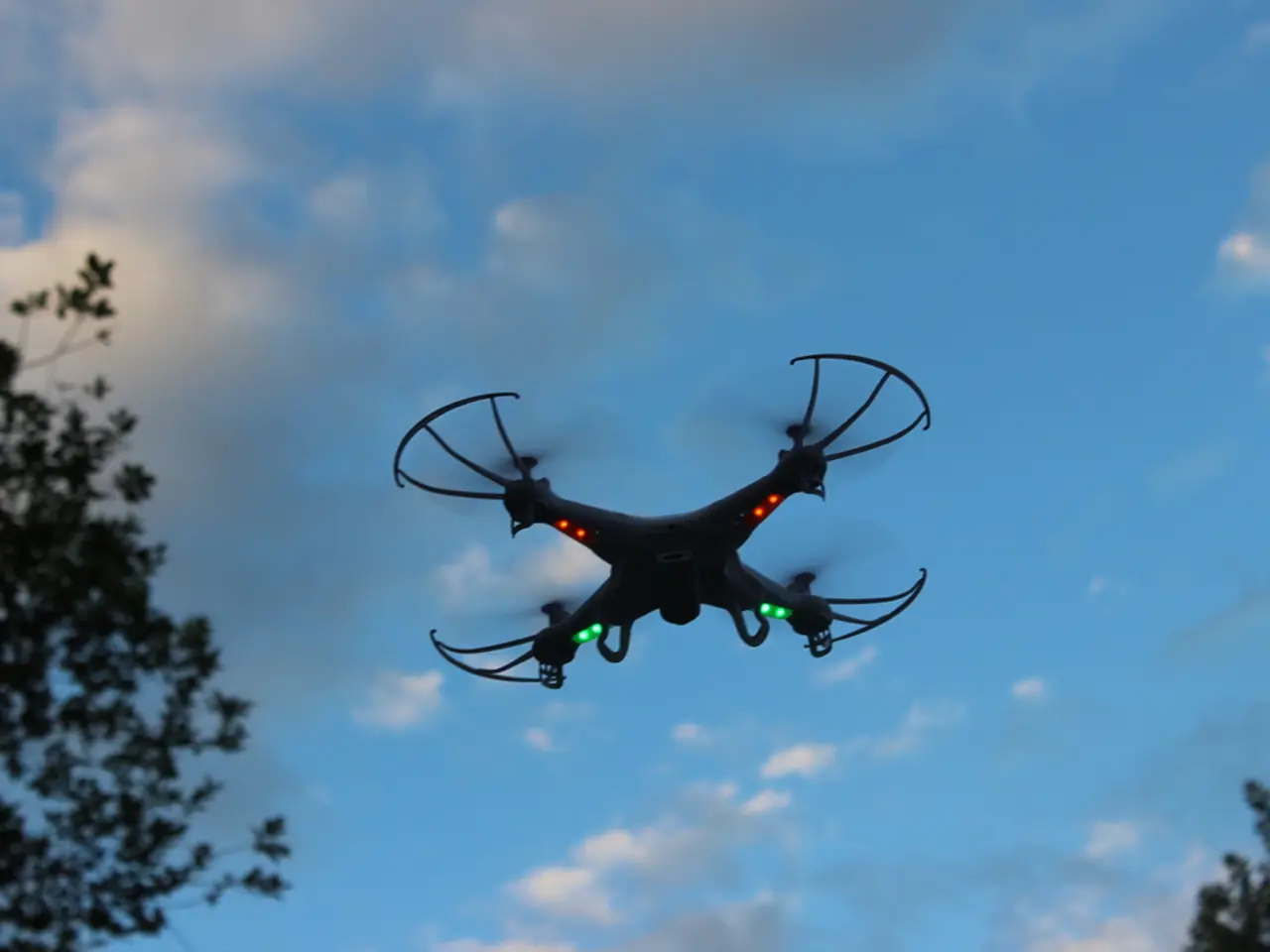Augmenting European Security: Automated Drone Operations for Increased Safety
In Europe, the landscape of public safety is undergoing a significant transformation, thanks to the implementation of Drone Operations Centers (DOCs). These centres are providing a much-needed boost to traditional methods, offering faster, safer, and more efficient emergency response solutions.
One of the key benefits of DOCs is the rapid deployment of drones to incident sites, often within minutes. This speedy arrival provides first responders with timely situational intelligence, without compromising the safety of officers or waiting for manned aircraft. This shift from reactive to proactive responses enables controlled responses rather than chaotic ones, a critical advantage in emergencies [2].
The use of advanced data, such as population density data from sources like Copernicus, allows DOCs to perform more accurate ground risk assessments for drone flights. This integration simplifies authorization processes, harmonizes regulations across Europe, and reduces operational risks [1].
DOCs also foster alignment of drone airspace management between civilian and military users, improving overall airspace efficiency, reducing conflicts, and enhancing situational awareness. This dual-use approach maximizes resource leverage and innovation [3].
Projects in countries like Spain and Belgium demonstrate that DOCs enable practical, scenario-driven drone deployments under harmonized EU regulations, making drone use more widespread, safer, and easily replicable across Europe [3].
Moreover, DOCs enable coordinated uses such as drone swarms for wildfire surveillance and suppression, integrated with traditional firefighting assets across multiple countries. This promotes early intervention and improves disaster resilience in ways that traditional methods alone cannot achieve [4].
In contrast, traditional public safety methods rely heavily on manned aircraft, ground personnel deployment, and slower intelligence gathering, which can delay critical response and expose responders to greater risk. DOCs provide an orchestrated, data-informed system that enhances operational speed, safety, and coverage, representing a transformational upgrade for European public safety operations [2][1][3][4].
The integration of DFR-EU technology is at the heart of this revolution, ensuring secure operation of the drones and preventing data leakage to third parties. European regulations also support Beyond Visual Line of Sight (BVLOS) operations and ensure consistent compliance with EU directives [5].
The system offered by our website provides comprehensive fleet management solutions for larger drone programs, including tools to monitor skills and experience of pilots, manage maintenance schedules for a larger fleet of drones and docking stations, and ensure strict compliance with SOPs and regulatory frameworks at both EU and national levels [6].
For more information about the Drone Operations Center and the cutting-edge solutions we offer that empower public safety agencies to protect and serve their communities better, visit our website. The DJI Dock, an advanced drone docking station, is also available for strategic placement throughout communities [7].
While the USA's system features numerous smaller agencies, each with a smaller workforce and, consequently, smaller drone teams, European agencies tend to be more integrated and responsive, thanks to the merging of American and European methods in drone use for public safety [8]. The USA's regulatory landscape, relying on case-by-case waivers and localized authorizations, is more complex and varied compared to Europe's harmonized approach [9].
In conclusion, the implementation of Drone Operations Centers in Europe is revolutionizing public safety by enhancing speed, safety, and effectiveness in emergency responses. This transformational upgrade offers a promising future for European public safety operations.
References:
[1] European Union Aviation Safety Agency (EASA). (2020). Regulation (EU) 2019/947 on the rules and procedures for the operation of unmanned aircraft. Retrieved from https://www.easa.europa.eu/sites/default/files/documents/2019-06/regulation-2019-0947_en.pdf
[2] European Union Agency for Network and Information Security (ENISA). (2018). Study on the security of drones in the EU: Drones in the EU: A new frontier for security. Retrieved from https://www.enisa.europa.eu/publications/drones-in-the-eu-a-new-frontier-for-security
[3] European Union Aviation Safety Agency (EASA). (2020). European U-space: A European system for the safe and secure integration of drones. Retrieved from https://www.easa.europa.eu/system/files/2020-02/european-u-space-vision-document.pdf
[4] European Union Satellite Centre (SatCen). (2018). Copernicus Emergency Management Service - Mapping of the Camp Fire in California. Retrieved from https://www.satcen.europa.eu/en/copernicus-emergency-management-service-mapping-camp-fire-california
[5] European Union Aviation Safety Agency (EASA). (2020). Opinion on the safety of operations of unmanned aircraft systems in the open category. Retrieved from https://www.easa.europa.eu/system/files/2020-06/opinion-on-the-safety-of-operations-of-unmanned-aircraft-systems-in-the-open-category.pdf
[6] Our website. (n.d.). Fleet management solutions for larger drone programs. Retrieved from https://ourwebsite.com/fleet-management-solutions
[7] DJI. (n.d.). DJI Dock. Retrieved from https://www.dji.com/dji-dock
[8] Federal Aviation Administration (FAA). (2019). Small Unmanned Aircraft Systems (sUAS) Integration Pilot Program. Retrieved from https://www.faa.gov/uas/programs_partnerships/integration_pilot_program/
[9] Federal Aviation Administration (FAA). (2016). Part 107 - Small Unmanned Aircraft Systems. Retrieved from https://www.faa.gov/regulations_policies/rulemaking/rules_advisories/media/Part-107-Summary.pdf
- The team at our website offers comprehensive fleet management solutions for larger drone programs, ensuring compliance with SOPs and regulatory frameworks at both EU and national levels.
- In the aerospace industry, DOCs are utilizing advanced data integration to perform more accurate ground risk assessments, simplifying authorization processes and reducing operational risks.
- Recent projects demonstrate that DOCs, with the help of DFR-EU technology, are offering safe, efficient, and replicable drone operations under harmonized EU regulations, like those in Spain and Belgium.
- The management of DOCs fosters alignment of drone airspace between civilian and military users, enhancing overall airspace efficiency, reducing conflicts, and increasing situational awareness.
- The smart-home device market is witnessing growth, but the aerospace industry, with the implementation of DOCs, is experiencing a significant transformation in public safety operations.
- With DOCs, first responders can obtain timely situational intelligence, thanks to the rapid deployment of drones to incident sites and the compliance with European regulations like Regulation (EU) 2019/947.
- The finance sector and businesses, apart from the gadgets and technology industry, can benefit from the safety advancements brought about by DOCs in emergency responses, such as in wildfire surveillance and suppression.
- In contrast to traditional methods, the introduction of DOCs in Europe is enabling controlled responses in emergencies, reducing the risk of chaotic situations and promoting early intervention.
- Manned aircraft, ground personnel deployment, and slower intelligence-gathering techniques still have their place in public safety, but DOCs offer an orchestrated, data-informed system that prioritizes speed, safety, and coverage, ultimately representing a transformational upgrade for European public safety operations.








